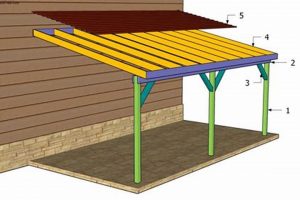The activity involving the installation, repair, or modification of floor surfaces utilizing individual planks or boards, undertaken by the homeowner or non-professional. This encompasses a range of tasks from replacing damaged sections to laying an entirely new wood floor. As an example, a homeowner might engage in this activity to renovate a living room, opting to install engineered wood planks themselves rather than hiring a contractor.
This endeavor offers several potential advantages, including cost savings compared to professional installation and a sense of personal accomplishment. Historically, the practice has been prevalent in owner-built homes and renovations where budgetary constraints necessitate a hands-on approach. The availability of online resources and pre-finished materials has further facilitated this trend, making it more accessible to individuals with limited prior experience.
The subsequent sections will delve into the specific tools required, preparation steps necessary, and techniques employed in accomplishing successful results in wooden floor projects. It will also address common challenges encountered and provide solutions to ensure a durable and aesthetically pleasing outcome.
Essential Considerations for Wooden Floor Projects
The following insights offer guidance for individuals embarking on the installation, repair, or modification of plank-based flooring.
Tip 1: Subfloor Preparation is Paramount. A level, clean, and dry subfloor is crucial for preventing future issues. Unevenness should be addressed with self-leveling compound or shims. Moisture barriers are advisable in areas prone to dampness.
Tip 2: Acclimatization Prevents Gaps. Allow the floorboards to acclimatize to the room’s temperature and humidity for several days before installation. This minimizes expansion and contraction after installation, reducing the likelihood of gaps.
Tip 3: Precise Measurements Ensure Efficiency. Accurate measurements are essential for minimizing waste and ensuring a proper fit. Double-check dimensions before cutting any boards.
Tip 4: Staggered Joints Enhance Stability. Stagger end joints randomly to distribute stress and improve the overall stability of the floor. Avoid creating patterns that draw attention to imperfections.
Tip 5: Utilize Proper Fasteners. Select appropriate fasteners based on the type of floorboards and subfloor. Consider using flooring nails, screws, or adhesives designed for wood flooring.
Tip 6: Expansion Gaps are Non-Negotiable. Maintain consistent expansion gaps around the perimeter of the room and around any vertical obstructions. These gaps allow for natural expansion and contraction, preventing buckling.
Tip 7: Proper Tool Selection is Crucial. Invest in quality tools such as a flooring nailer, tapping block, and pull bar to facilitate the installation process and achieve a professional finish.
Adhering to these guidelines enhances the longevity, appearance, and structural integrity of wooden floor installations. Careful planning and execution are vital for achieving satisfactory results.
The subsequent section will provide steps to ensure the wooden floor projects are durable.
1. Subfloor Preparation
Subfloor preparation constitutes a foundational element in any wood floor installation endeavor. Proper execution directly influences the stability, longevity, and overall aesthetic appeal of the finished floor. The integrity of the subfloor acts as the bedrock upon which the entire flooring system relies.
- Leveling and Flattening
An uneven subfloor introduces stress points and potential weak spots in the finished floor. Self-leveling compounds, shims, or sanding can rectify irregularities. Failure to level the subfloor may result in creaking, bowing, or premature wear of the floorboards. Consider a situation where a homeowner installs hardwood over a noticeably sloping subfloor; this leads to an uneven walking surface and potential joint separation over time.
- Cleaning and Debris Removal
The presence of debris, such as nails, staples, or remnants of previous flooring, interferes with proper adhesion and seating of the new floorboards. Thoroughly sweeping, vacuuming, and scraping the subfloor eliminate these impediments. Neglecting this step can cause unevenness and potential damage to the underside of the floorboards. Visualize a scenario where small pebbles are left embedded in the subfloor. These pebbles can create pressure points that eventually compromise the integrity of the new floor, leading to visible indentations or cracks.
- Moisture Mitigation
Excessive moisture in the subfloor is detrimental to wood flooring, leading to warping, cupping, and potential mold growth. Moisture barriers, such as polyethylene sheeting or liquid-applied membranes, mitigate moisture migration. Assessing moisture levels with a moisture meter is advisable before installation. If installing wood flooring directly over a concrete slab without a moisture barrier, the likelihood of moisture-related problems significantly increases, potentially ruining the new floor.
- Securing and Reinforcing
Loose or damaged subfloor panels compromise the stability of the finished floor. Securing loose panels with screws and reinforcing weak areas with additional framing ensures a solid foundation. Neglecting this aspect can result in excessive movement and squeaking in the finished floor. Imagine installing a wood floor over a subfloor with loose plywood sheets. Every step will create noise and vibration, eventually leading to loose boards and potential structural issues.
Effective subfloor preparation addresses each of these facets comprehensively. Ensuring a level, clean, dry, and structurally sound subfloor is not merely a preliminary step but an integral component of a successful and enduring floor installation. This attention to detail pays dividends in the form of a floor that remains stable, attractive, and functional for years to come.
2. Acclimation Period
The acclimation period represents a critical phase within wood flooring installations. It directly impacts the dimensional stability of wood products and, consequently, the overall success of undertaken renovation, repair, or new construction.
- Moisture Content Equilibrium
Wood is hygroscopic, absorbing and releasing moisture in response to ambient humidity levels. Acclimation allows the floorboards to reach equilibrium moisture content (EMC) with the environment in which they will be installed. Installing wood before it has acclimated can result in expansion or contraction post-installation, leading to gaps, buckling, or warping. For example, if wood flooring is stored in a damp garage and then immediately installed in a dry, climate-controlle
d living room, it will likely shrink as it loses moisture, resulting in unsightly gaps. - Dimensional Stability and Reduction of Stress
Fluctuations in moisture content cause wood to expand and contract, generating internal stresses. Acclimation minimizes these stresses by allowing the wood to gradually adjust to its new environment. This reduces the risk of the floorboards cupping, crowning, or otherwise deforming after installation. Consider the scenario where flooring is installed immediately after delivery during winter: the relative humidity is low. As summer arrives and the humidity rises, the boards absorb moisture and try to expand, the resulting pressure damages the floor.
- Subfloor Considerations During Acclimation
The subfloor’s moisture content also influences the acclimation process. Ideally, the subfloor should be near its own EMC before the flooring is delivered. This prevents the subfloor from drawing moisture from or adding moisture to the flooring during acclimation. Installing wood flooring over a damp concrete subfloor, even after proper acclimation of the boards, can lead to moisture-related problems down the line, as the subfloor continuously introduces moisture to the flooring.
- Duration and Stacking Methods
The required acclimation period varies depending on the type of wood, its initial moisture content, and the environmental conditions. Typically, 3-5 days is recommended, but longer periods may be necessary in areas with extreme humidity variations. Proper stacking of the floorboards during acclimation is also important. Boards should be spaced apart to allow for air circulation around each piece. Solid hardwood typically needs more time than engineered products.
In summary, the acclimation period is indispensable for ensuring wood floor surfaces retain their integrity and aesthetic appeal. Adequate attention to this phase prevents costly repairs and contributes to a lasting, high-quality flooring installation. Deviation from recommended acclimation guidelines, often driven by a desire for expediency, frequently results in compromised performance and diminished value.
3. Precise Measurements
The correlation between accurate measurements and successful floorboard installation is direct and consequential. Precise dimensions are not merely an initial step; they form the bedrock upon which the entire project rests. Erroneous measurements precipitate a cascade of complications, resulting in material wastage, compromised aesthetic outcomes, and increased labor expenditure. For example, if room dimensions are underestimated, insufficient material will be purchased, leading to project delays. Conversely, overestimated dimensions result in unnecessary costs and potential disposal issues. The accurate calculation of square footage, accounting for irregularities and obstructions, is therefore paramount.
In practical application, precise measurements dictate the cutting strategy for floorboards. Complex layouts, such as those involving angled walls or intricate patterns, demand meticulous attention to detail. The “measure twice, cut once” adage is particularly relevant in this context. Consider a scenario where a homeowner neglects to accurately measure a doorway transition. The resulting ill-fitting floorboard necessitates rework, consuming both time and resources. Furthermore, small cumulative errors in measurement amplify over the course of a large area, creating significant discrepancies at the perimeter.
In summary, accurate measurement serves as a cornerstone of effective wood floor installation. Deviations from precision introduce inefficiencies and negatively impact the final product’s quality. Mastery of basic measurement techniques, coupled with a commitment to thoroughness, significantly enhances the likelihood of a successful floorboard renovation, repair, or new construction. This understanding bridges theoretical knowledge with practical application, highlighting the integral role of measurement in achieving professional-quality results.
4. Staggered Joints
The practice of staggering joints in wood floor installations, a core component of floorboards DIY, significantly influences the structural integrity and aesthetic appeal of the finished surface. This arrangement involves offsetting the end joints of adjacent rows of floorboards, preventing a continuous line from forming across the floor’s width or length. The primary effect is to distribute weight and stress more evenly across the subfloor, mitigating the risk of localized weaknesses and promoting long-term stability. For instance, without staggered joints, a concentrated load on a single point where multiple joints meet could cause deflection or even structural failure. Staggering, conversely, allows the load to be dispersed over a wider area, enhancing the floor’s resistance to deformation.
Furthermore, staggered joints contribute significantly to the visual appeal of wood flooring. A random or near-random pattern creates a more natural and aesthetically pleasing look compared to a uniform, grid-like appearance. In cases where floors are to be laid across large expanses, failing to stagger can make imperfections or minor misalignments in individual boards far more visible. Staggering, when done with attention to variation, disguises these minor inconsistencies, creating a more homogeneous look. A common recommendation is to avoid joints that are too close together, as tight groupings can create visually distracting clusters. For practical application, floorboards should be laid, as much as possible with consideration for minimizing the amount of cuts.
In summary, the implementation of staggered joints in floorboards DIY is a crucial technique that directly impacts both the durability and the aesthetic quality of the finished floor. This simple yet effective method addresses potential structural weaknesses and enhances the visual texture of the surface. Understanding and applying this principle is essential for achieving professional-looking results and ensuring long-term satisfaction with a wood floor installation.
5. Proper Fasteners
The selection and utilization of appropriate fasteners represent a critical juncture in any floorboards project. The integrity and longevity of the installation hinges significantly on the correct choice and application of these components. Incorrect fasteners can lead to a multitude of issues, ranging from squeaking floors to complete structural failure.
- Nail Gauge and Length
The gauge and length of nails must be carefully considered in relation to the thickness and type of the wood floorboards and the subfloor material. Undersized nails lack the holding power necessary to secure the boards, leading to movement and potential squeaking. Conversely, overly long nails can penetrate too deeply into the subfloor, potentially interfering with underlying utilities or compromising the subfloor’s integrity. For example, installing -inch hardwood flooring over a plywood subfloor typically requires nails that are at least 2 inches long and of an appropriate gauge for the nail gun being used.
- Screw Type and Thread Pattern
Screws offer superior holding power compared to nails, particularly in applications where the floorboards are subject to significant stress or movement. The type of screw, such as wood screws or self-tapping screws, and the thread pattern must be compatible with both the floorboard material and the subfloor. Using the wrong type of screw can result in stripped threads, split wood, or inadequate fastening. Consider the installation of hardwood flooring over a concrete subfloor. In this scenario, concrete screws with specialized thread patterns are essential to ensure a secure and lasting bond.
- Adhesive Compatibility and Application
Adhesives play a crucial role in bonding floorboards to the subfloor, especially in engineered wood or laminate flooring installations. The adhesive must be compatible with both the flooring material and the subfloor, and it must be applied in accordance with the manufacturer’s instructions. Insufficient adhesive application can lead to loose boards and uneven surfaces, while excessive application can result in adhesive bleed-through and difficulty in fitting the floorboards together. For example, using a moisture-cure urethane adhesive for engineered wood flooring over a concrete slab requires careful attention to the adhesive’s open time and the proper trowel notch size to ensure adequate coverage.
- Fastener Spacing and Pattern
The spacing and pattern of fasteners directly impact the stability and appearance of the finished floor. Consistent and uniform spacing is essential to distribute the load evenly and prevent localized weaknesses. Inadequate fastener density can result in cupping, crowning, or movement of the floorboards. For instance, installing solid hardwood flooring requires fasteners to be spaced closer together in high-traffic areas or near walls to prevent gapping or edge lifting. Following manufacturer recommendations regarding fastener spacing and pattern is paramount for achieving a durable and aesthetically pleasing result.
In conclusion, meticulous attention to fastener selection, application, and spacing is an indispensable aspect of any floorboards project. Employing the correct fasteners, tailored to the specific flooring materials and subfloor conditions, ensures a stable, long-lasting, and aesthetically pleasing floor. Neglecting this critical element can compromise the entire installation, leading to premature failure and costly repairs.
6. Expansion Gaps
Expansion gaps are an essential consideration in the successful execution of floorboards projects. These deliberately created spaces around the perimeter of the room and against vertical obstructions allow for the natural expansion and contraction of wood flooring due to changes in temperature and humidity. Their omission can lead to significant structural problems.
- Preventing Buckling and Warping
Wood is a hygroscopic material, meaning it absorbs and releases moisture from the surrounding environment. This process causes dimensional changes in the wood. When floorboards expand without adequate space, they exert pressure against walls and other fixed elements, resulting in buckling, warping, or even the lifting of the flooring. The severity of these issues is exacerbated in areas with significant seasonal humidity fluctuations. Without expansion gaps, even minor changes in humidity result to damage in the floorboards.
- Accommodation of Seasonal Changes
Wood flooring experiences its greatest dimensional changes during seasonal shifts in humidity. During humid months, the wood absorbs moisture and expands, while during drier months, it releases moisture and contracts. Expansion gaps accommodate these cyclical changes, preventing undue stress on the flooring and the surrounding structure. Properly sized expansion gaps act as a buffer, mitigating the forces exerted by the expanding and contracting wood.
- Sizing and Placement Considerations
The appropriate size of expansion gaps depends on several factors, including the type of wood, the width of the room, and the expected humidity variations. Generally, a gap of 1/4 to 1/2 inch is recommended around the perimeter of the room. This gap should be maintained consistently along all walls and around any pipes, columns, or other vertical obstructions. Failure to maintain consistent gap sizes can lead to uneven expansion and localized stress points. It should be noted that manufacturer’s instructions should be followed.
- Concealment and Aesthetics
While expansion gaps are necessary for the structural integrity of the floor, they are often concealed by baseboards, quarter-round molding, or other trim elements. These trim pieces cover the gap while allowing the floor to move freely underneath. The selection of appropriate trim profiles and finishes is crucial for achieving a seamless and aesthetically pleasing transition between the floor and the walls.
The successful incorporation of expansion gaps in floorboards projects requires careful planning and execution. Adherence to recommended sizing and placement guidelines, coupled with appropriate trim selection, ensures a durable and visually appealing result. Neglecting this fundamental aspect of wood floor installation can compromise the integrity of the entire flooring system, leading to costly repairs and diminished aesthetic value.
Frequently Asked Questions
The following addresses common inquiries regarding the installation, repair, and maintenance of wood flooring by non-professionals.
Question 1: What tools are absolutely essential for undertaking a typical floorboards DIY project?
A minimum toolset comprises a measuring tape, circular saw or miter saw, flooring nailer or stapler, tapping block, pull bar, moisture meter, and safety glasses. Optional but recommended tools include a jigsaw, self-leveling compound, and knee pads.
Question 2: How crucial is moisture testing of the subfloor and new floorboards prior to installation?
Moisture testing is paramount. Excessive moisture in either the subfloor or floorboards can lead to warping, cupping, and adhesive failure. Industry standards dictate specific moisture content ranges based on wood species and installation environment.
Question 3: What is the recommended acclimation period for floorboards before installation, and what factors influence its duration?
The standard acclimation period is typically 3-5 days. However, this duration is influenced by the wood species, its initial moisture content, and the relative humidity of the installation environment. Observe manufacturer guidelines.
Question 4: How can one ensure proper subfloor preparation to prevent issues such as squeaking or unevenness in the finished floor?
Subfloor preparation entails leveling, cleaning, and ensuring structural soundness. Leveling can be achieved using self-leveling compound or shims. Securing loose subfloor panels and addressing any structural deficiencies are also crucial.
Question 5: What is the significance of expansion gaps, and how should they be properly implemented during a floorboards project?
Expansion gaps are critical for accommodating the natural expansion and contraction of wood flooring. A gap of approximately to inch is typically recommended around the perimeter of the room and any vertical obstructions.
Question 6: What are some common mistakes to avoid when undertaking floorboards project?
Common pi
tfalls include neglecting subfloor preparation, inadequate acclimation, improper fastener selection, insufficient expansion gaps, and failure to follow manufacturer instructions.
Adhering to these guidelines and addressing these frequently asked questions enhances the likelihood of a successful and long-lasting wood flooring installation.
The next section will address material selections and costs for floorboards.
Concluding Remarks on Wooden Floors
This exploration of floorboards acknowledges the multifaceted nature of the undertaking. From subfloor preparation to acclimation, fastener selection, and expansion gaps, each element significantly influences the overall outcome. The preceding insights underscore the importance of meticulous planning and execution in order to achieve a durable, aesthetically pleasing, and structurally sound floor.
Thoughtful consideration of the principles outlined herein is essential for success. The longevity and performance of any wood floor installation are directly correlated with the degree to which these foundational aspects are understood and diligently applied. A commitment to quality materials and precise techniques ensures that effort yields lasting value and satisfaction.



![Diya Aur Baati Hum: Illuminate Your Home [DIY Guide] The DIY Hub: Creative Crafts, Repairs & Life Hacks Diya Aur Baati Hum: Illuminate Your Home [DIY Guide] | The DIY Hub: Creative Crafts, Repairs & Life Hacks](https://craftingdiycenter.com/wp-content/uploads/2025/07/th-5913-300x200.jpg)



